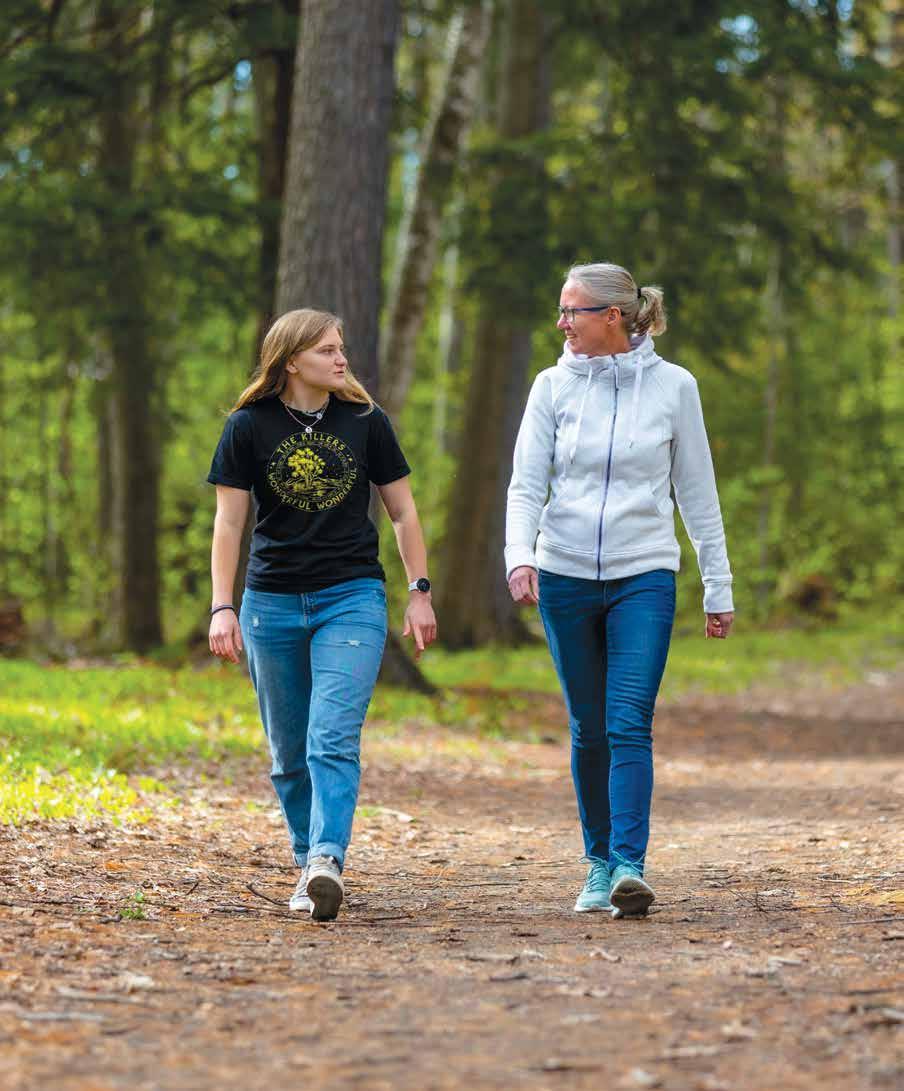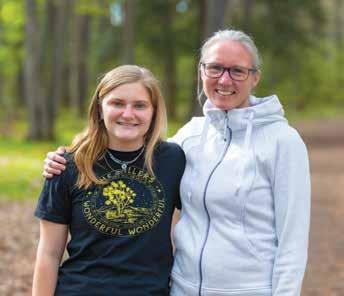
5 minute read
Skiing Toward Equality: Leadership Is Persistence
BY IZZY QUAM ’25
In January 2022, 81 collegiate skiers lined up on a cloudy day at the Quarry Road Trails in Waterville, Maine. They were getting ready to ski eight laps of a two-and-a-half-kilometer loop, to make up the first women’s 20-kilometer race in collegiate skiing history. I was one of those athletes, and I was nervous. Although I had skied 20 kilometers before, I had never raced it.
Eleven months later, on November 27, Frida Karlsson of Sweden glided across the finish line, a smile on her face and arms extended wide, winning the first women’s 20-kilometer pursuit in the World Cup.
These historic moments are all thanks to Molly Peters, 47, Nordic skiing head coach and men’s and women’s cross country head coach at Saint Michael’s College.
For 11 years, Peters painstakingly, persistently worked to instigate equal distances in skiing, which allows everyone to have equal opportunity in racing, changing the competition around the globe.
Until this year, races in the International Ski and Snowboard Federation
(FIS) Cross Country Skiing World Cup did not have equal distances for men and women. When women were finally allowed to participate in FIS cross country competition in 1954, it was believed that they were not able to ski as far as men and their reproductive systems would be damaged by endurance sports, so their race distances were kept shorter. While men would ski 50 kilometers, women would ski 30. In the Skiathlon, men would ski 30 kilometers and women would ski 15. Even in sprints, men would often ski .1 or .2 kilometers further than the women. Similarly, in collegiate skiing, women typically ski five kilometers less than men. In many cases, this would mean women are skiing half the distance the men ski. It was not until 1952 that women’s Nordic skiing made its debut in the Olympics, 28 years after the men’s inclusion.
For many athletes, the different distances are insulting. “It just felt like a slap in the face a little bit. It felt to me like I was not as valued as my male teammates because I was being told that I was less capable than them,” said Grace Erholtz ’23, captain of the Saint Michael’s Nordic ski team, which with equal opportunity racing,” Peters explains. “If you are consistently creating an environment where women are treated like second-class citizens and only allowed to race shorter distances, it demonstrates to all genders that women are not capable,” Peters said. “I am a coach, and I am a mother. I do not want my athletes or my children to ever think that women are less capable.” is made up of both women and men. In a major change, this year, the distances for men and women, at least on the FIS level, are the same.
Peters started skiing when she was 5. Her parents bought skis for Molly and her brother and mounted lights on the outside of their house so they could ski around while their parents were inside. Peters did not always want to ski race. It wasn’t until she was 10 and she went with her brother to the New England Bill Koch Youth Ski League Festival that her perspective on racing changed. When another skier forgot her skis, Peters stepped in and raced in her place—and fell in love with it. “I was hooked. I loved it.
“It’s important for the sport to be free of gender bias and to provide all genders
I loved racing and I didn’t even know that I loved racing because I had never raced before,” said Peters.
Peters went on to a successful competitive skiing career, winning Junior Nationals in high school, and becoming an All-American in college at Middlebury. But the different distances between men’s and women’s races always bothered her. achieve equal time is equal distance. As part of her proposal, Peters began to use data and graphs to demonstrate the relationship between time on course, and equal distance.

According to Pennie McEdward Rand, Saint Michael’s Nordic skiing assistant coach, it was Peters’s leadership that was instrumental in turning the tide with respect to equal distance at the national level. Others agreed. “Molly changed the landscape,” said Justin Beckwith, competitive program director at the New England Nordic Ski Association (NENSA), in a Zoom interview.
When Peters became a skiing coach at Saint Michael’s 11 years ago, she submitted a proposal to the Eastern Intercollegiate Ski Association within her first year. It immediately got shot down. Peters was told they would not change the college format until the international races changed their format. After that, Peters would bring it up about every other year, and each time, she gained a little more support. Peters believed the more often she brought it up, the more the idea became normalized.
Like many others, Peters was stuck at home during the COVID-19 pandemic, so she decided to put all of her energy into the equal distance effort. “I was bored and decided that if there was ever a time that I could put everything that I had into trying to get the distances changed, it was then,” Peters said. She started reaching out to other coaches and athletes, including Olympic gold medalist Jessie Diggins, to try to gain traction. Peters was trying to get support for
In 2021, Peters presented at the U.S. Ski & Snowboard Association (USSA) Congress and got a positive response. But it was not quite enough. “It was the first moment that I felt like it possibly stood a chance to change, and it did not,” Peters said. While the proposal for equal distance did not pass, the USSA did agree to host more equal distance events.
Peters spoke again at the 2022 USSA Congress. This time, she gained more traction, and the U.S. ski team ultimately put in a proposal to FIS asking for equal distance for the 2022–2023 World Cup season. The proposal passed with 57 percent support. It was not an overwhelming victory, but it was enough.
The concept of equality in Nordic skiing is expanding beyond the distance of the races. This year, FIS is granting teams extra coaching bibs, specifically for women coaches. This will allow teams that take advantage of the program to have more coaches on the course. Nordic coaching has historically been male dominated.

Peters’s work is not done. Equalizing distance in crosscountry running is her next step. Although FIS has adopted equal distance, the NCAA has not completely done so. The NCAA Oversight Committee set unequal distance last fall.
Peters has written a letter to the NCAA Championship Oversight Committee asking them to overturn the NCAA’s proposal. Its proposed distances are a 20k for everyone, and then a 10k for men and a 5k for women. The NCAA’s explanation for its refusal to adopt equal distance is that it is “inappropriate” for women to race 10 kilometers and it is “inappropriate” for men to race five kilometers, with no further information given.
One idea that has come up in response to equal distance is equal time. “A lot of people talk about equalizing time on course, which we’ve found is really not true,” Peters said, arguing that the best way to a proposal to the USSA, in hopes of changing women’s distances. The proposal got signatures from well-known names in the skiing community including Diggins, Bill Koch, Brian Gregg, and Caitlin Gregg.
The skiing world has taken notice, and momentum is growing. Midwest Junior National Qualifier races and Eastern Cup races will be equal distance. The only difference in distances will be between age groups, not gender.
The jaws dropped on all of her athletes when Peters told them the NCAA’s decision, during a rainy Saturday morning practice. But Peters is not one to give up. “I’m going to fight it to the very end,” Peters said.







